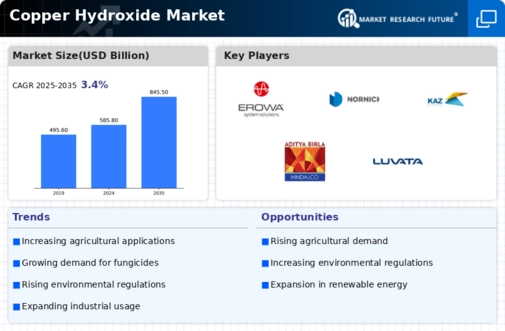The Copper Hydroxide Market is currently characterized by a dynamic competitive landscape, driven by increasing demand in agriculture, particularly as a fungicide, and the growing need for sustainable agricultural practices. Key players such as BASF SE (Germany), Ferro Corporation (US), and Jiangxi Copper Corporation Limited (China) are strategically positioning themselves to leverage these growth opportunities. BASF SE (Germany) focuses on innovation and sustainability, investing in research to develop more effective formulations. In contrast, Ferro Corporation (US) emphasizes regional expansion and supply chain optimization, enhancing its market presence in North America. Jiangxi Copper Corporation Limited (China) appears to be concentrating on vertical integration, which may provide it with a competitive edge in terms of cost efficiency and product quality. Collectively, these strategies contribute to a moderately fragmented market structure, where competition is intensifying as companies seek to differentiate themselves through innovation and operational efficiency.
In terms of business tactics, companies are increasingly localizing manufacturing to reduce lead times and enhance responsiveness to market demands. This approach not only optimizes supply chains but also aligns with regional regulatory requirements, which can vary significantly across different markets. The competitive structure of the Copper Hydroxide Market is moderately fragmented, with several players vying for market share. The collective influence of these key players is shaping the market dynamics, as they adopt various strategies to enhance their competitive positioning.
In August 2025, BASF SE (Germany) announced a partnership with a leading agricultural technology firm to develop advanced copper-based fungicides that are more environmentally friendly. This strategic move underscores BASF's commitment to sustainability and innovation, potentially allowing it to capture a larger share of the market by appealing to environmentally conscious consumers and regulatory bodies. The collaboration may also enhance its research capabilities, leading to the development of new products that meet evolving agricultural needs.
In September 2025, Ferro Corporation (US) expanded its manufacturing capabilities by opening a new facility in Mexico, aimed at increasing production capacity for copper hydroxide. This expansion is likely to enhance Ferro's supply chain efficiency and reduce costs, positioning the company favorably against competitors. The strategic location of the new facility may also facilitate better access to key markets in North America, thereby strengthening its competitive stance in the region.
In July 2025, Jiangxi Copper Corporation Limited (China) announced the acquisition of a smaller competitor specializing in copper hydroxide production. This acquisition is expected to bolster Jiangxi's production capacity and diversify its product offerings. By integrating the acquired company's operations, Jiangxi may achieve greater economies of scale, which could lead to improved profitability and a stronger market position.
As of October 2025, the Copper Hydroxide Market is witnessing trends such as digitalization and sustainability becoming increasingly central to competitive strategies. Companies are leveraging technology to enhance operational efficiencies and product development processes. Strategic alliances are also shaping the landscape, as firms collaborate to innovate and meet regulatory demands. Looking ahead, competitive differentiation is likely to evolve from traditional price-based competition to a focus on innovation, technological advancements, and supply chain reliability, reflecting a broader shift in market dynamics.
















Leave a Comment